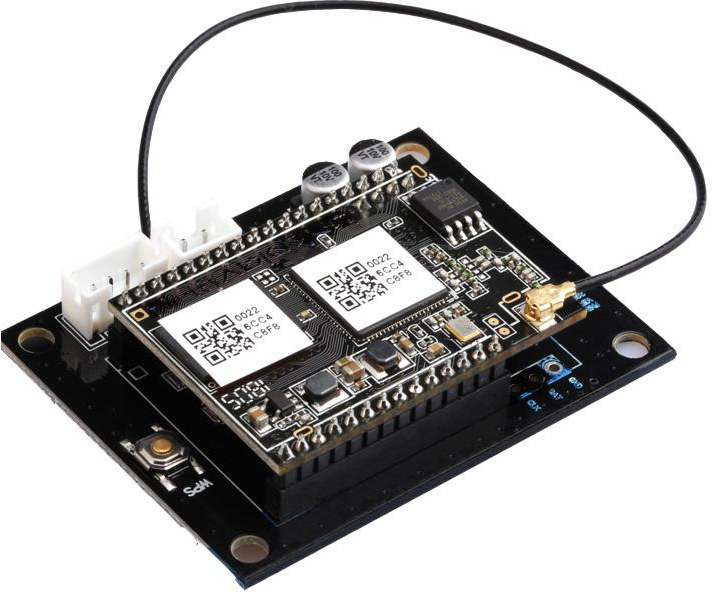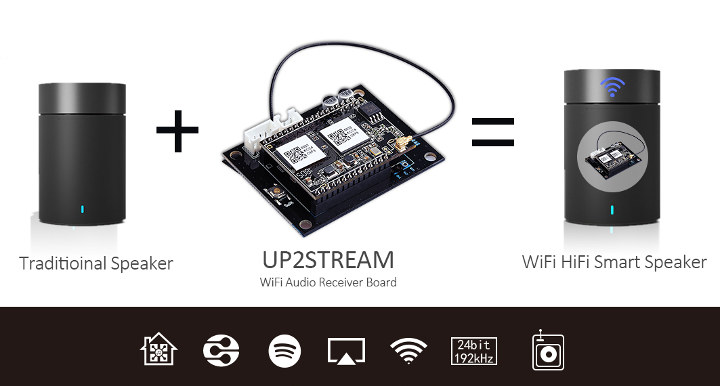If you own a set of very good speakers, and are interested in making them smarter, Arylic Up2Stream WiFi audio receiver module may be a solution to look into.
The module allows to make your own DIY wireless speakers by adding WiFi connectivity, and features such as multiroom, AirPlay, DLNA streaming, Spotify, and Internet radio streaming.
Up2Stream (WA31) hardware specifications:
- SoC – MediaTek MT7688AN MIPS processor @ up to 580 MHz
- System Memory – 64MB DDR2
- Storage – 16MB flash
- Connectivity – 2.4GHz 802.11 b/g/n 1T1R WiFi up to 150 Mbps with 5 dBi I-PEX antenna
- Audio – 24-bit / 192 KHz decoding, 20 Hz – 20KHz frequency range, 4-pin speaker connector with 2.0mm pitch
- USB – 1x USB 2.0 port port
- Power Supply – 5VDC / 1A via 2-pin header (2.0mm pitch)
- Power Consumption – 160 to 320 mA
- Dimensions – 55.21 x 41.37mm
The module ships with a 2-pin power cable, a 4-pin audio cable, and adhesive antenna, and a user manual.
Up2Stream is mostly for hardware conversion, as the company explained to me the firmware for the board is not open source since the multiroom streaming software is quite complicated to implement reliably. They do offer AllStream app for Android (root needed) and iOS (not available yet?) to control the board, as well as an HTTP API to remotely manage audio and networking. However they are not willing to publish the documentation publicly, and instead customers can request “WIFI Audio HTTP API” document detailing the API by email.
The module can be purchased directly on Arylic website for $32.99, or if you prefer more familiar websites, Aliexpress and Amazon.

Jean-Luc started CNX Software in 2010 as a part-time endeavor, before quitting his job as a software engineering manager, and starting to write daily news, and reviews full time later in 2011.
Support CNX Software! Donate via cryptocurrencies, become a Patron on Patreon, or purchase goods on Amazon or Aliexpress








This really should’ve had Bluetooth support as well.
At least the price is kind of acceptable.
It is possible with this kind of board, you have to implement it or buy it here :
https://fr.aliexpress.com/item/Spotify-Connect-WIFI-Module-Amplifier-2-412GHz-2-484GHz-For-Wireless-Intelligent-Cloud-Sound-System-DLNA/32946485645.html
Seems to be the same hardware (they’ve clearly tried to hide it, as if you look the Linkplay text has been coated in black, but it’s still just visible in the larger picture above), just different carrier board, which enabled more functionality on the one you linked to.
OR: You could just take a random SBC running Linux or Android (any old Android phone, tablet or box will also do) and install a Logitech Media Server client (aka Squeezebox), together with the server somewhere in your net (e.g. on your router or NAS). Supports multiroom, DLNA, playback from the media server or internet stream, favorites and playlist management, internet radio search, etc.
Looks far more complicated and expensive than simply using an up2stream module. Moreover, keep in mind that Raspberry Pi analog audio output is just a piece of crap ! So, to have a quality setup you need a SBC + a dedicated DAC….
I agree with previous comment: if it had bluetooth connectivity , i would have buy it !
I’ve made a lot of tests : the audio quality from an very old iphone is a lot superior to the expensive DAC audio. So that’s true : an old iphone with ipeng (which transform your iphone in squeezebox compatible with airplay , spotify connect and many others) has a better sound and can do many more. Don’t forget it when you want to transform an old music device into connected device
There’s https://www.hifiberry.com/ for RPi high end audio lovers.
This is interesting only if the Spotify playback work without a premium account. Otherwise this is pretty useless you can just use MPD on a linux SBC.
Very interesting idea, but the post is incomplete, since for normal Hi-FI speakers you ALSO need a power amplifier.
(unless you have “active” speakers)
Maybe will be a good DIY project for my Christmas weekend, to buy a cheap second hand HI-FI amplifier and “plug-in” the Up2Stream module. 😉
http://www.arylic.com , there is amplifier products there.
Too expensive if you compare to orange pi. But it’s ready to use. This kind of board is integrated to a lot of devices (I.am.D V200, airmusic, audiocast, Ieast… ).
This is linkplay who seems to be the leader in this kind of music devices, but the price for DIY users is too expensive.
There are some devices ready to use ,in a box (not sell like a board module) which contains this kind of board and is less expensive.
This board should cost 15-19$ I think.
Proof? Links please
The proof is here : pretty old but same module integrated in a box for less money…
https://www.cnx-software.com/2016/01/11/audiocast-m5-is-a-chromecast-audio-alternative-with-local-audio-files-and-multi-room-support/
In this case, then SONOS wouldn’t be popular . When you can connect all audio system and control by one app like smart home, you will feel it worth that . and the audio quality ,no distance limitation .
You seem to think that the most popular is the best … Sonos is popular thanks to a great communication and a great image. But most of their speakers has a poor quality (I don’t speak about the Sonos Play:1 which is a great product if you think about the price and the small size of the speaker). What you said about sound quality and distance limitation you can do exactly the same with this kind of module. I spoke about the V200 before, I can assure that the sound quality of this amp (which integrate linkplay) is superior to sonos.
But I can’t said that Sonos don’t have great functionalities as the jack input on the amp which can be sync with all other sonos speakers.
Hey bro, don’t know if you are still active. But I want to ask if can we connect on any medium, be it mail or social media. You seem to be quite knowledgeable, and I want to implement this similar idea of multiroom streaming. So, it would be great if we can connect in any way. My email: lsagwal14@gmail.com
Products just using Bluetooth are dirt cheap on Aliexpress, below £10 in. cost